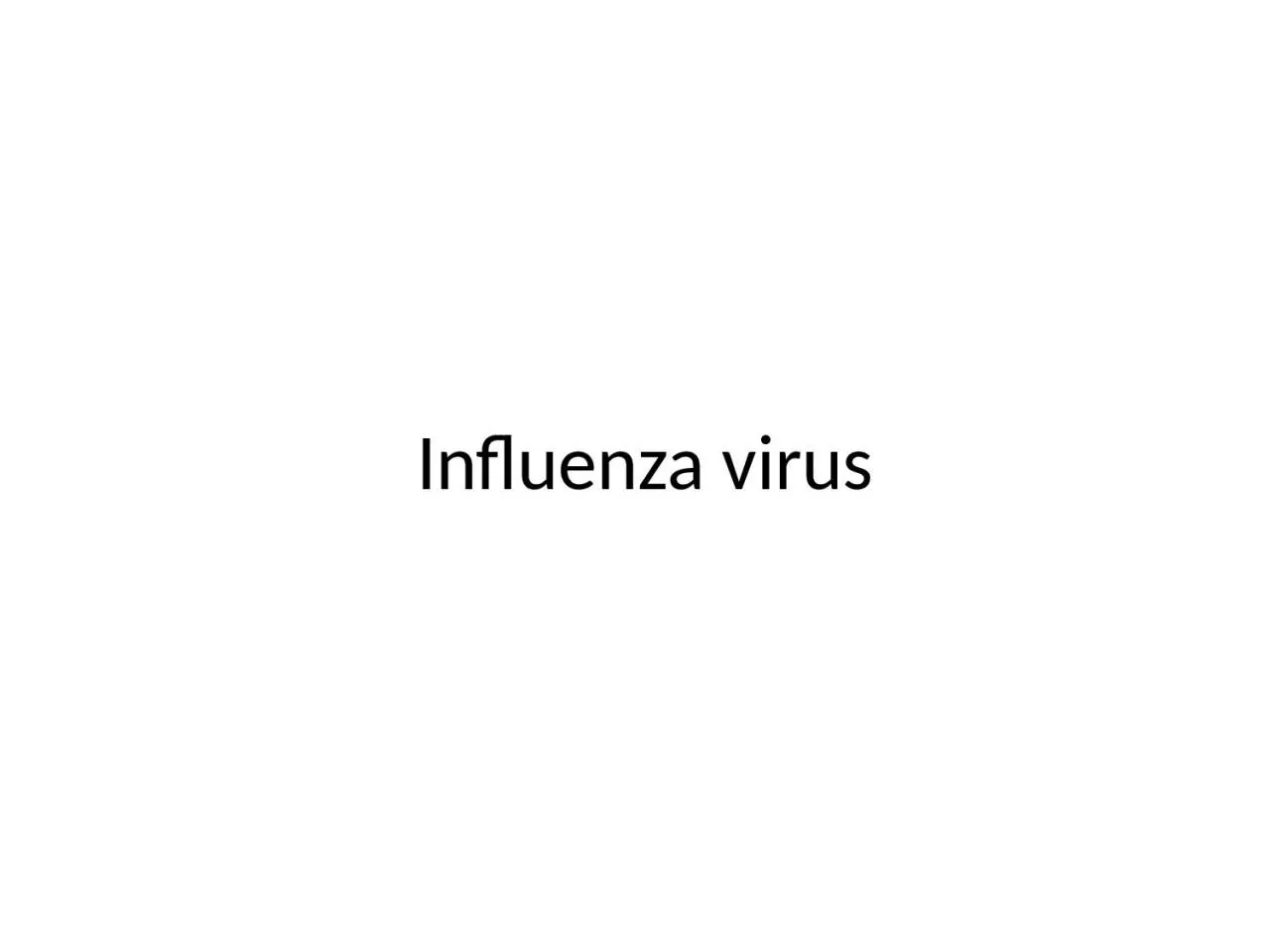

The influenza virus group consists of three enveloped RNA members of the family Orthomyxoviridae influenza A B and C Influenza A viruses are further classified into hemagglutinin H and neuraminidase ID: 936004
Download Presentation The PPT/PDF document "Influenza virus Overview of influenza vi..." is the property of its rightful owner. Permission is granted to download and print the materials on this web site for personal, non-commercial use only, and to display it on your personal computer provided you do not modify the materials and that you retain all copyright notices contained in the materials. By downloading content from our website, you accept the terms of this agreement.
Slide1
Influenza virus
Slide2Overview of influenza virus
The influenza virus group consists of three enveloped RNA members of the family Orthomyxoviridae:
influenza A, B, and C.
Influenza A
viruses are further classified into hemagglutinin (H) and neuraminidase
(N) subtypes based on activity of their surface envelope glycoproteins.
Influenza A viruses
infect humans
and other animal (for example, avian and swine) hosts.
Influenza B viruses
infect only humans.
Influenza C
viruses
are rarely recognized in humans.
Slide3H and N surface envelope glycoproteins (antigenic variation) change frequently. Minor changes (
antigenic
drift
) are partly responsible for seasonal outbreaks or epidemics that occur almost yearly. Major changes
(
antigenic shift
) are alterations in the virus caused by reassortment of genes between human and animal
influenza A strains. Emergence of a new influenza virus for which humans have no previous protective
immunity may result in severe worldwide pandemics
.
Slide4Influenza A outbreaks generally occur in winter, with attack rates of 10% to 20%
.
Seasonal influenza
disproportionately affects persons 65 years of age or older. Very old persons, very young children, persons
with chronic medical conditions, and pregnant women often develop severe disease, which accounts for most
hospitalizations and deaths attributable to this infection. In pandemics, disease extends beyond the usual
season with higher attack rates and increased mortality in all age groups, especially otherwise healthy young
adults
Slide5The highly pathogenic
H5N1
avian influenza virus predominantly affects children and young adults
recently exposed to infected birds and poultry in Europe and Asia. Person-to-person human transmission
appears to be limited. The novel
H7N9
influenza virus in China is also believed to result from exposure to
infected poultry or contaminated environments. To date, no evidence of sustained person-to-person spread
has been found.
Slide6Clinical features and evaluation
:
Influenza virus is transmitted by sneezing and coughing. After an incubation period of 1 to 4 days, patients
develop fever, headache, myalgia, pharyngeal irritation, and respiratory symptoms (dry cough and nasal
discharge). Mild or asymptomatic infections occur, particularly with influenza B. Viral shedding begins 24 to
48 hours before symptom onset and may continue for 5 to 10 days.
Slide7Patients with uncomplicated infection
improve within 2 to 5 days.
The most common complications are primary influenza pneumonia and
secondary bacterial pneumonia
, which are mainly responsible for increased morbidity and mortality in
patients aged 65 years and older
Slide8During a confirmed local influenza outbreak, infection can be reliably diagnosed on the basis of clinical
criteria alone. When confirmation is needed,
rapid antigen tests
of respiratory samples from nasopharyngeal
swabs detect both influenza A and B. Positive test results are highly specific. However, sensitivity ranges
from 40% to 80%. Detection of viral nucleic acid by polymerase chain reaction
(PCR)
is rapid, has high
sensitivity and specificity, and can determine the type and subtype of influenza virus.
Slide9Serologic assays are
useful only for diagnosing infection retrospectively
.
Whether to test is based on how the result will influence
management
;
testing is generally reserved for patients at high risk for complications, including adults older
than 65 years, immunocompromised patients, pregnant and postpartum women, and health care workers
Slide10Antiviral therapy begun within 48 hours of symptom onset reduces symptom
duration, decreases hospitalization rates, and reduces the incidence and severity of complications; however,
adults younger than 65 years without high-risk conditions are unlikely to benefit from antiviral therapy begun
later. When treatment is required, the neuraminidase inhibitors oseltamivir and zanamivir are active against
influenza A and B.
Slide11Oseltamivir or zanamivir
is recommended for patients with confirmed or highly suspected
influenza infection who have an increased risk for complications.
Peramivir
, an intravenous neuraminidase
inhibitor, was approved for use in adults in 2014. All hospitalized patients should receive a neuraminidase
inhibitor promptly, even if 48 hours or more has elapsed since disease onset. Treatment duration is generally
5 days but may be longer in immunocompromised or severely ill patients.
Slide12PREVENTION: vaccine and antiviral agents.
VACCINE: inactivated vaccines are the main control measures.
Recommendation of vaccination:
1-more than 65 year old.
2-All patients aged 6 months or older in a clinical risk group(chronic respiratory disease, chronic heart disease, chronic kidney disease, chronic liver disease,diabetes,immunosuppressed people,asplenia,pregnancy,morbid obesity.
3-All children aged between 2-16 years not in clinical risk group
Vaccination is also offered to: household contact to of immunocompromised people, health care workers, others as clinical judgment suggests(
e.g:other
chronic illnesse,long-term care home residents).
4- two doses are required in children under 9 years who have been not previously vaccinated. Otherwise single dose is sufficient, usually given in October
5-The main contraindication to vaccination is :hypersensitivity to hens eggs.
6- protection is around 70% and lasts for 1 year. Diminished responses are seen in organ transplant recipients receiving immunosuppressive therapy. Protection is reduced in elderly.